近年来,气溶胶与雷暴云电活动的关系逐渐成为学术界关注的重点。国内外研究者通过光、闪电定位、卫星遥感等观测手段,获得了一大批气溶胶和闪电活动的观测资料。一些学者通过对比不同区域的闪电活动特征,发现气溶胶对闪电活动作用明显(Westcott, 1995; Lyons et al., 1998; Murray et al., 2000; Orville et al., 2001; Williams and Stanfill, 2002; Steiger and Orville, 2003; Kar et al., 2009)。例如,Williams and Stanfill (2002)对比陆地和海洋上的闪电活动发现,随着气溶胶含量的增加,闪电活动增强。Steiger and Orville (2003)还发现受城区工商业发展的影响,城市地区的闪电活动高于郊区。最新研究表明,气溶胶可通过辐射效应抑制对流发展,导致闪电活动减弱(Tan et al., 2016)。由此可知,气溶胶含量和闪电活动的关系极为复杂。由于观测手段的限制,为全面了解气溶胶影响雷暴云起放电过程的内在机理,还需借助模式进一步分析。
目前,国内外学者已开展相应的模式研究。Mitzeva et al. (2006)利用一维云动力模式模拟陆地和海洋雷暴云指出,相对于海洋雷暴云而言,陆地型雷暴云中上升气流强,云滴和冰相粒子较多,云内起电过程强。Shi et al. (2015)基于二维雷暴云起放电模式,通过设置不同气溶胶化学组分、浓度及谱分布进一步探讨了气溶胶在海陆电活动差异中的作用。一些研究通过对比污染型雷暴云和清洁型雷暴云的动力、微物理及电过程发现,污染型雷暴云中云滴数浓度高,对流发展更为旺盛,冰相粒子浓度更高,使云中起电量和闪电频次增加(Wang et al., 2011; Zhao et al., 2015; 谭涌波等, 2017)。此外,受商业、交通及工业影响,不同地区的气溶胶含量差异明显,有关雷暴云电活动对气溶胶浓度响应的研究逐渐被开展。Mansell and Ziegler (2013)利用三维体积云模式探讨气溶胶作为云凝结核(Cloud Condensation Nuclei, CCN)对雷暴云电过程的影响,发现当CCN浓度低于2000 cm-3时,增加CCN,霰粒子增多,闪电活动增强,其电荷结构可由偶极演变为三极。Tan et al. (2017)在二维雷暴云模式中指出,冰晶和霰粒子随气溶胶的增加先增多后保持稳定,起电率先增加后降低,但对电荷结构的影响并不明显。从这些研究结果来看,气溶胶影响雷暴云电过程的模拟结果尚存在较大差异,这可能与模式对雷暴云微物理过程描述的差异有关(Mansell and Ziegler, 2013)。
气溶胶作为CCN主要通过改变云滴物理特性来影响雷暴云的动力、微物理过程,进而影响雷暴起电、电荷结构和闪电活动(邓美玲等, 2017; 谭涌波等, 2017)。那么,对云滴微物理过程的准确描述是研究气溶胶与电过程相互关系的基础。相关研究表明:对流层上部云滴冻结会释放热量,促进对流发展,对云内冰相粒子的生成和发展起着重要的作用(Heymsfield and Sabin, 1989; Heymsfield and Miloshevich, 1993; Heymsfield et al., 2005; Fan et al., 2007; 赵鹏国等, 2016)。而冰相粒子是雷暴云起电的主要粒子(Takahashi, 1978; Gardiner et al., 1985),这势必会对云内的起电和放电过程造成极大的影响。因此,为了提高模式的模拟能力和进一步了解气溶胶浓度影响雷暴云电过程的物理机制。本研究基于已有的二维雷暴云起、放电模式,植入云滴冻结方案,并设置多种气溶胶背景进行数值模拟试验。通过对比不同气溶胶背景下云内各水成物粒子含量及分布的差异,进而揭示气溶胶浓度与雷暴云起电、电荷结构的内在联系。
2 模式简介本文选用谭涌波(2006)、谭涌波等(2006, 2007)改进后的二维高分辨率雷暴云起、放电数值模式,其云模式框架来源于中国气象科学院(胡志晋和何观芳, 1987)。该模式假定大气为无粘性可压缩流体,忽略地转偏向力,采用非静力平衡条件以及笛卡尔坐标系(76 km×20 km),分辨率为250 km×250 km,计算雷暴云微物理发展过程。其微物理过程主要包括凝结蒸发、碰并、自动转化、核化繁生、融化冻结等。考虑的水成物主要有:云滴、雨滴、冰晶、霰以及雹,并且这些粒子具有双参数谱(混合比、数浓度)。
模式中的起电过程考虑非感应起电和感应起电过程。非感应起电参数化方案采用修改后的Gardiner方案,即Gardiner-Pereyra方案(Shi et al., 2015)。它主要考虑的是冰晶与霰粒子的碰撞,其单次碰撞后获得的电荷与冰晶、霰的直径大小、下落末速度、相对碰撞速率以及反转温度的系数有关。感应起电则采用Ziegler et al. (1991)参数化方案,考虑冰相粒子(霰和雹)与云滴的碰撞分离。感应起电不仅与云滴和冰粒子的数浓度、直径大小、下落速度等有关,还依赖于环境电场的大小。闪电放电参数化方案基于谭涌波等(2006)、Tan et al. (2014)的研究,闪电的启动采用两种初始击穿条件:一种是取随高度变化(Height-varying)的逃逸电子电场阈值;另一种是当模式中任意一点的场强超过常规空气击穿阈值(取为160 kV m-1)。此后双向发展,闪电通道的扩展采用步进(step-by-step)方式,即每次正负通道各自只扩展一个后继通道点(Mansell et al., 2002)。
该模式对云的微物理发展以及电过程有一定的模拟能力。在此基础上,为使模拟结果更为合理,本研究将原模式中的冰晶核化经验公式(Fletcher, 1962)替代为Sun et al. (2002)的同质核化方案和Cooper (1980)的异质核化方案;利用改进的模式、耦合气溶胶模块,探讨雷暴云电过程对气溶胶浓度的响应。下面将对模式的改进、气溶胶初始场以及活化方案进行详细描述。
2.1 模式改进原模式中的冰晶核化方案采用Fletcher(1962)实验室测得的冰核活化经验公式,并未考虑冰晶的同质核化—云滴冻结过程,这与实际雷暴云的微物理过程是不符的。因此,本文对现有模式加以改进,考虑云滴冻结转化为冰晶,其云滴冻结方案为
| $ {Q_{{\rm{cif}}}} = \left\{ \begin{array}{l} {p_{\rm{c}}} \cdot {Q_{\rm{c}}}/2\Delta t,{\kern 1pt} \;\;\;\;\;{\kern 1pt} - 40{\kern 1pt} {\kern 1pt} ^\circ {\rm{C}} < T < - 20{\kern 1pt} {\kern 1pt} ^\circ {\rm{C}}\\ {\kern 1pt} {Q_{\rm{c}}}/2\Delta t,{\kern 1pt} {\kern 1pt} \;\;\;\;\;\;\;\;\;T \le - 40{\kern 1pt} {\kern 1pt} ^\circ {\rm{C}}{\kern 1pt} {\kern 1pt} \end{array} \right. $ | (1) |
其中,Qcif代表云滴核化率,即云滴冻结生成冰晶的浓度;Δt代表时间步长;T为云内温度;Qc是云水混合比;pc为水滴冻结的百分数,其值随温度变化而变化,可表示为:
| $ {p_{\rm{c}}} = 0.008 \times {1.274^{{T_0} - T}}, $ | (2) |
式中T0为水滴开始冻结的温度,其值取-20 ℃,即云内的水滴冻结,从-20 ℃开始部分冻结,到-40 ℃时全部冻结(Sun et al., 2002)。
雷暴云内冰晶的生成除了云滴冻结,其异质核化方案参照实验室(Cooper, 1980)得到的经验公式:
| $ {N_{{\rm{in}}}} = 0.005 \times {\rm{exp(}} - {\rm{0}}{\rm{.304}} \times T{\rm{)}} , {\rm{ }} - 40 ^\circ {\rm{C}} \le T \le 0 ^\circ {\rm{C}} $ | (3) |
其中,Nin为异质核化率,这里异质核化产生的冰晶数目仅与温度有关,考虑云内水汽过饱和度的影响(胡志晋和何观芳, 1987),将公式(3)修改为
| $ {N_{{\rm{in}}}} = \left\{ \begin{array}{l} \frac{{ - {\rm{0}}{\rm{.304}} \times 0.005{e^{ - {\rm{0}}{\rm{.304}}T}}}}{{{\rho _{\rm{0}}}}} \cdot {\left({\frac{{{Q_{\rm{v}}} - {Q_{{\rm{si}}}}}}{{{Q_{{\rm{sw}}}} - {Q_{{\rm{si}}}}}}} \right)^k} \cdot \frac{{{\rm{d}}T}}{{{\rm{d}}t}} , \\ \;\;\;\;\;\;\;\;\;\;\;\;\;\;\;\;\;\;\;\;\;\;\;\; \frac{{{\rm{d}}T}}{{{\rm{d}}t}} < 0且{Q_{\rm{v}}} > {Q_{{\rm{si}}}}\\ 0, \;\;\;\;\;\;\;\;\;\;\;\;\;\;\;\;\;\;\;\;\;\;\;\; \frac{{{\rm{d}}T}}{{{\rm{d}}t}} \ge 0 且{Q_{\rm{v}}} \le {Q_{{\rm{si}}}} \end{array} \right. $ | (4) |
其中,Qv为实际水汽含量,Qsi为相对冰面的饱和水汽含量,k =5,
考虑布朗运动及重力沉降作用的影响,气溶胶随高度的增加呈指数关系递减(Yin et al., 2000)。因此,模式中设置气溶胶浓度随高度的增加呈指数关系递减:
| $ {N_{\rm{a}}}(z) = {N_0} \times \exp ( - z/{z_{\rm{s}}}), $ | (5) |
其中,N0为气溶胶的初始浓度(地面处的气溶胶浓度);Na(z)代表不同高度层的气溶胶浓度;zs为气溶胶的标高,参照Yin et al. (2000)取固定值2 km。此外,对气溶胶各个网格点初始化时,假设每个高度层的气溶胶浓度均匀分布,则只需给出地面的气溶胶浓度就可以算出整个空间的气溶胶分布。
可溶性的气溶胶粒子(硫酸盐等)可增长为云滴,影响云的微物理发展。本文在改进后的二维雷暴云起、放电模式中耦合一种经典的气溶胶活化方案:
| $ {N_{{\rm{ccn}}}} = {C_0}{S^r}, $ | (6) |
其中,Nccn代表活化的CCN数浓度,S代表云中的水汽过饱和度。r与气溶胶的化学成分和物理性质有关,本文r取值0.7(Wang, 2005)。C0用来表示气溶胶的初始浓度(Li et al., 2008)。由此可知,气溶胶能够活化成云滴的数目不仅与气溶胶的初始浓度有关,还依赖于云内的水汽过饱和度。在此基础上,为了判断是否有新的云滴生成,参照谭涌波等(2017)给出诊断过程:
| $ {N_{\rm{c}}} = \max \left[ {({N_{{\rm{newc}}}} - {N_{{\rm{oldc}}}})/\Delta t, 0} \right], $ | (7) |
其中,Nc代表云滴的活化率,Noldc是前一时间步长的云滴数浓度,Nnewc代表新时间步长算出的可活化云滴数浓度。如果Nnewc>Noldc,有新的云滴生成。
2.3 试验个例及初始扰动条件本文选取雷暴云内电过程的综合研究(Studies of Electrical Evolution in Thunderstorms, SEET)试验1999年7月31日发生的一次山地雷暴过程来进行数值模拟,对应时刻的温湿层结曲线和垂直风廓线如图 1所示。此外,模式启动时在模拟区域中心,高度为1 km的格点上给出了一个水平和垂直半径分别为5 km、1 km的湿热泡扰动,其温度扰动和湿度扰动分别取4.0 K和80%,从中心向外以余弦函数递减。通过改变公式(5)中的N0来表征气溶胶浓度的变化,共设置4组模拟试验,N0分别为100、500、1000、3000 cm-3,模拟时间为80 min,时间步长为2 s。
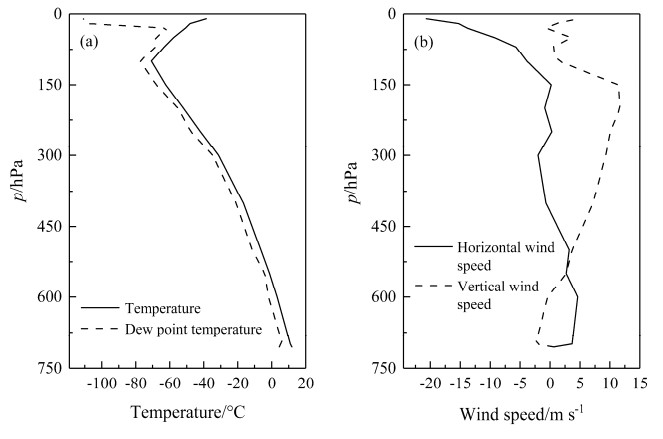
|
图 1 SEET个例的(a)环境温湿层结(实线代表环境温度、虚线代表露点温度)和(b)风的垂直廓线(实线代表水平风场、虚线代表垂直风场) Fig. 1 (a) Environment temperature and humidity stratification (solid line represents the environment temperature and dashed line represents the dew point temperature) and (b) wind vertical profile (solid line represents horizontal wind and dashed line represents vertical wind) |
图 2给出了云滴和雨滴数浓度和混合比随时间的变化。从图中可以看出:在雷暴云发展的前30 min内,随着气溶胶浓度的增加,云滴的混合比和数浓度均增加。当N0=100 cm-3时,云滴最大混合比仅为3.52 g kg-1,最大数浓度为3.90×107 kg-1,而N0=3000 cm-3时,其最大混合比和数浓度分别可达9.69 g kg-1、6.68×108 kg-1。相对于云滴混合比的增加,其数浓度增加更为明显,因此云滴的尺度逐渐减小。这是因为在相同的水汽条件下,更多的CCN活化成云滴争夺水汽凝结增长,形成更多的小云滴,使得云滴尺度随气溶胶浓度的增加逐渐降低。这与之前的研究结论是一致的(Yin et al., 2000; Mansell and Ziegler, 2013; Tan et al., 2017; 邓美玲等, 2017)。此外,从垂直分布上来看,云滴均分布在-40 ℃以下,-40 ℃以上高度没有液态水的存在。而且随着气溶胶浓度的增加,更强的上升气流能够将云滴抬升得更高,当N0=3000 cm-3时,云滴最高可到达8 km处(见图 2g)。随着雷暴云的继续发展,伴随云内其它粒子的形成,云水不断被消耗,云滴开始减少并消失。

|
图 2 云滴[左列,Qc和Hc分别为云水混合比和云滴数浓度,黑色等值线分别代表数浓度为106、107、108、109 kg-1,红实线代表等温线(-40 ℃和0 ℃)]和雨滴(右列,Qr和Hr分别为雨水混合比和雨滴数浓度,黑色等值线分别代表数浓度103、104、105、106 kg-1)混合比(填色)与数浓度(等值线)的时空分布。图中数值代表垂直方向上各层的最大值,下图与此相同 Fig. 2 Spatial and temporal distributions of the mixing ratio (shadings) and the number concentration (contours) of cloud droplet [left column; Qc and Hc represent the mixing ratio and number concentration of cloud droplet, respectively; black contours represent the number concentration 106, 107, 108, and 109 kg-1, respectively; red solid lines represent the isotherm (-40 ℃ and 0 ℃)] and raindrop (right column; Qr and Hr represent the mixing ratio and number concentration of raindrop, respectively; black contours represent the number concentration 103, 104, 105, and 106 kg-1, respectively). The numbers represent the maximum values in each layer in the vertical direction; the same hereafter |
相反,雨滴的数目和混合比随气溶胶浓度的增加均减少,且雨滴首次出现的时间延迟。当N0由100 cm-3变化到3000 cm-3时,雨滴出现的时间延迟了约15 min。这是因为小云滴的碰并效率低,云雨自动转化率降低,抑制了雨滴对云滴的收集,使得云内的暖雨过程受到抑制。因此,气溶胶浓度越高,雷暴云中的小云滴停留时间更长(见图 2g)。当气溶胶浓度大于500 cm-3后,雨滴多分布于0 ℃层以下,此时雨滴的形成则主要源于霰粒子的融化。这符合Mansell and Ziegler (2013)的研究结论,在气溶胶浓度较低时,雨滴的形成和增长主要来自云雨的自动转化和雨滴对云滴的收集。而当气溶胶浓度较高时,雨滴的形成则源于0 ℃层以下冰相粒子的融化。
此外,水汽在CCN表面凝结形成云滴释放潜热,将云水和水汽抬升到冻结层之上,从而有利于冰相粒子的产生。考虑云滴冻结过程对冰相粒子的贡献,图 3给出了云滴核化率(80 min内的平均值)随高度的变化,即冰晶含量的垂直分布。可以看出,云滴冻结产生的冰晶主要分布在雷暴云的中上部4~9 km处,最大值出现在6 km处,而且随着气溶胶浓度的增加,云滴核化率相应增加。当N0从100 cm-3增加至3000 cm-3时,云滴冻结产生的冰晶含量可由1.0×10-4 g kg-1增长至1.2×10-3 g kg-1。这是因为暖雨过程的减弱,更多的小云滴随上升气流抬升到冻结高度以上,未降落的云滴冻结产生更多的冰晶。图 4是冰晶和霰粒子的混合比和数浓度随时间的变化。冰晶均分布在冻结层以上,在-40 ℃以上高度处,云滴全部冻结形成冰晶,导致该高度以上不再有液态水的存在(见图 2)。同时,气溶胶浓度越高,冰晶形成的时间越早。对照图 3可以看出,云滴冻结使云内低温区的冰晶含量急剧增加(见图 4g)。当N0从100 cm-3增加至3000 cm-3时,冰晶的最大数浓度由3.86×107 kg-1增加至1.84×109 kg-1,冰晶的混合比则由1.73 g kg-1增加到8.88 g kg-1。不难发现,随着气溶胶浓度的增加,相对于冰晶混合比的增加,其数浓度增加得更加显著,冰晶尺度随着气溶胶的增加逐渐减小。
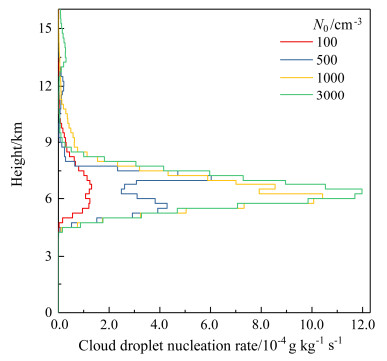
|
图 3 云滴核化率的垂直分布(红色实线代表N0=100 cm-3,蓝色实线代表N0=500 cm-3,黄色实线代表N0=1000 cm-3,绿色实线代表N0=3000 cm-3) Fig. 3 Vertical distribution of cloud droplet nucleation rate (red solid line represents N0=100 cm-3, blue solid line represents N0=500 cm-3, yellow solid line represents N0=1000 cm-3, and green solid line represents N0=3000 cm-3) |
对比霰粒子随气溶胶浓度的变化,因冰晶数目的增多,更多的冰晶自动转化成霰,使N0=500 cm-3时的霰粒子最多,增长最快,其最大数浓度可达5.16×105 kg-1,最大混合比为12.94 g kg-1(见图 4d)。继续增加气溶胶,霰粒子数浓度开始减小,而且首次生成霰粒子的时间也明显延迟(见图 4f和4h)。这主要是因为:1)冰晶的尺度随着气溶胶浓度的增加显著减小,霰粒子的启动项——冰霰自动转化过程减弱,使霰粒子的生成受到抑制;2)暖雨过程减弱,雨滴较少,冰晶碰并雨滴冻结成的霰也在减少。当气溶胶浓度高于1000 cm-3后,霰粒子的生成受到极度抑制,最大数浓度已减少到8.87×103 kg-1。但此时的霰粒子和较多的小云滴碰并增长使得霰粒子可以继续增长,其混合比的减小并不明显(见图 4h)。
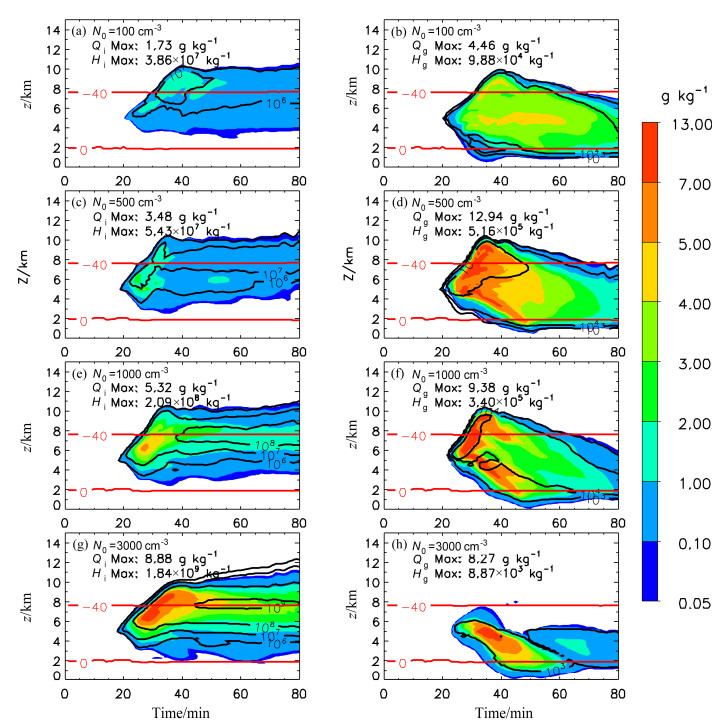
|
图 4 冰晶(左列,Qi和Hi分别为冰晶的混合比和数浓度,黑色等值线分别代表数浓度106、107、108、109 kg-1)和霰(右列,Qg和Hg分别为霰的混合比和数浓度,黑色等值线分别代表数浓度103、104、105、106 kg-1)混合比(填色)与数浓度(等值线)的时空分布 Fig. 4 Spatial and temporal distributions of the mixing ratio and number concentration of ice crystal (left column; Qi and Hi represent the mixing ratio and number concentration of ice crystal, respectively; black contours represent the number concentration 106, 107, 108, and 109 kg-1, respectively) and graupel (right column; Qg and Hg represent the mixing ratio and the number concentration of graupel, respectively; black contours represent the number concentration 103, 104, 105, and 106 kg-1, respectively) |
因此,随着气溶胶浓度的增加,冰晶含量增加,霰粒子先增加,后因小冰晶的增多而急剧减少。对比Tan et al. (2017)的研究结果,他们发现随着气溶胶浓度的增加,冰粒子含量先增加后趋于稳定,不会出现霰粒子急剧减少的情况。本文考虑云滴冻结过程后,冰晶的大量形成使得其尺度减小,在相同的水汽条件下,冰晶难以增长为大尺度的霰粒子。这样的结论与Mansell and Ziegler (2013)的研究结果是吻合的。
3.2 雷暴云起电特征对比雷暴云中的电荷主要源自水成物粒子之间的碰撞起电。目前,雷暴云内的起电机制主要分为非感应起电机制和感应起电机制。本文中的非感应起电采用冰晶和霰之间的碰撞起电机制,感应起电则采用霰与云滴之间的碰撞。根据以上的讨论,气溶胶浓度的改变使得云内可参与起电的粒子(云滴、冰晶和霰粒子)均受到影响。那么,它是否同样会对雷暴云的起电过程产生影响呢?图 5给出了最大非感应起电率(冰晶所获电荷)随时间的变化。非感应起电均发生在22 min左右,并在30~40 min达到最大值。云内的起电主要分布在低温区(-15~-40 ℃),高温区的非感应起电率较弱,且仅在液态水含量大于1 g kg-1时发生极性反转,-40 ℃高度处以上由于液态水的不存在而不再起电。因此,冰晶主要获得正电荷,霰获得负电荷。
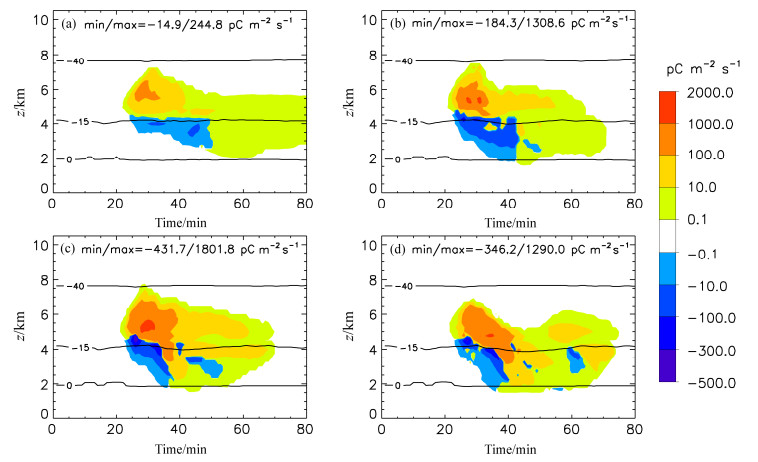
|
图 5 最大非感应起电率随时间的变化:(a)N0=100 cm-3;(b)N0=500 cm-3;(c)N0=1000 cm-3;(d)N0=3000 cm-3。黑实线代表等温线(0 ℃、-15 ℃和-40 ℃) Fig. 5 The evolution of non-inductive charging rate: (a) N0=100 cm-3; (b) N0=500 cm-3; (c) N0=1000 cm-3; (d) N0=3000 cm-3. The black solid lines represent the isotherms (-40 ℃, -15 ℃, and 0 ℃) |
非感应起电率的大小与其起电粒子(冰晶、霰粒子)的微物理特征密切相关。从图 5可以看出,随着气溶胶浓度的增加,非感应起电逐渐增强,垂直分布更广,当N0=1000 cm-3时,非感应起电率达到最大1801.80 pC m-2 s-1,随后非感应起电率开始减小(见图 5c和5d)。这主要是因为:随着气溶胶数目的增多,更多的冰晶与霰粒子碰撞导致起电更强。当气溶胶浓度高达一定值时,虽然冰晶数目很多,但小尺度的冰晶和少量的霰粒子最终抑制了起电(见图 5d)。因此,雷暴云内的起电过程不仅与冰晶和霰粒子的数目有关,还与其尺度的大小有关,大粒子之间的碰撞起电更为强烈,分离出的电荷量更大(Li et al., 2008; Mansell and Ziegler, 2013)。
云内冰相粒子间的非感应碰撞起电过程使得环境电场增强,在该环境电场的作用下,开始发生感应起电。表 1给出了最大感应起电率和最大非感应起电率的数值对比。其中,正感应起电率表示为霰获得正极性电荷,相反,云滴则获得负极性电荷。对比表 1中的感应起电率可以发现,更多的霰粒子与云滴碰撞使得感应起电在N0=500 cm-3时明显增强,但是随着气溶胶浓度的继续增加,霰粒子数目急剧减少导致感应起电减弱(见图 4右列)。相较于非感应起电率,感应起电率的量级较小。由此可知,雷暴云内的电荷主要由冰相粒子间的非感应起电贡献。此外,其他关于起电机制的研究也指出,感应起电过程较弱,非感应起电在整个起电过程中起主要的作用(Takahashi, 1978; Saunders et al., 1991; Ziegler et al., 1991; Mansell and Ziegler, 2013)。
|
|
表 1 个方案的非感应起电率和感应起电率 Table 1 The non-inductive charging rate and inductive charging rate in four cases |
空间的电荷结构由雷暴云内粒子间的碰撞起电而形成,同时电荷结构又直接影响着闪电放电特征(Mansell et al., 2005)。那么,气溶胶在空间电荷结构的演变过程中又将扮演怎样的角色呢?图 6给出了雷暴发展初期(24 min)、旺盛期(40 min)和消散期(60 min)的电荷结构变化。对比不同时期的电荷结构发现,在雷暴云的发展初期,电荷结构均呈正偶极性,电荷主要分布在4~8 km。不同的是,气溶胶浓度的增加导致主正电荷区和主负电荷区的空间分布更广。对照相应时刻的冰晶和霰粒子的分布(见图 4c和4d)发现,更多的霰和冰晶碰撞起电使得电荷密度在N0=500 cm-3时达到最大。随着雷暴不断发展至旺盛期,开始形成底部有少量正电荷的三极性电荷结构。电荷密度随着气溶胶浓度的增加而增大,在N0=1000 cm-3时达到最大,随后电荷密度逐渐减少,这与非感应起电率的变化趋势是一致的。此外,对比相应时刻的非感应起电率,可以发现N0=3000 cm-3时非感应起电率的垂直分布较低,因此,整个电荷的中心高度降低(见图 6k)。在雷暴消散期,底部正电荷区逐渐消失,电荷结构又演变为偶极性。气溶胶浓度越高,底部正电荷区消失得更快。紧接着,主负电荷区减小,主正电荷区变大,导致主正电荷区大于主负电荷区。相关研究指出,正是这样的差异使正电荷可挣脱负电荷区的束缚到达地面,从而发生正地闪(Coleman et al., 2003; 谭涌波等, 2017)。
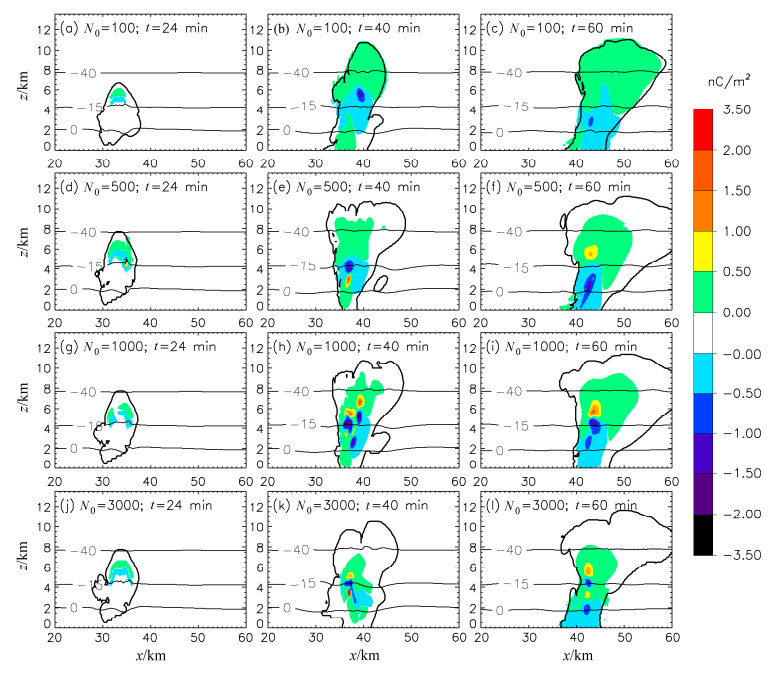
|
图 6 雷暴发展不同时刻的电荷结构(填色为电荷密度,粗黑线代表雷暴云的轮廓) Fig. 6 The charge structure distribution in different stages (shadings represent the charge density and thick black line represents the outline of the thunderstorm) |
综上可知,雷暴云的空间电荷结构与起电过程密切相关,空间电荷密度的大小及分布由于起电程度的不同存在一定的差异。但在本研究中,气溶胶浓度的改变不会影响雷暴云的电荷结构特征。不同气溶胶背景下的雷暴云,其空间电荷结构均由偶极性发展为三极性,再以偶极性逐渐消散。其它相关研究也得到相似的结论(师正等, 2015; 邓美玲等, 2017),但对比Mansell and Ziegler (2013)的研究结果,他们指出CCN浓度从50 cm-3变化到1500 cm-3,电荷结构可由偶极性发展为三极性;当CCN浓度高达5000 cm-3时,整个雷暴云过程的电荷结构均呈偶极性。这样的差异可能与模式中微物理方案的设置有关。
4 结论本文在已有的二维雷暴云起电、放电模式的基础上,植入云滴冻结方案;利用改进后的模式,结合一次山地雷暴个例,通过改变气溶胶初始浓度进行敏感性模拟试验。重点分析了气溶胶浓度的改变对雷暴云微物理、起电过程的影响,并给出不同气溶胶浓度下电荷结构的差异,得到以下结论:
(1) 气溶胶浓度的改变对雷暴云内各水成物粒子的含量作用明显。气溶胶浓度越高,云滴数目越多,但云滴的尺度逐渐减小;小云滴导致云雨的自动转化率降低,雨滴的形成受到抑制,且首次形成雨滴的时间延迟。伴随气溶胶浓度的增加,雨滴的主要形成机制由云雨自动转化过渡为冰相粒子的融化;云滴在低温区冻结导致冰晶快速生长,冰晶数浓度随气溶胶浓度的增加而增大。因水汽条件有限,冰晶的大量形成使得其尺度变小,在气溶胶浓度大于1000 cm-3后难以增长成大尺度的霰粒子。因此,霰粒子数浓度先增加后急剧减小。
(2) 由于感应起电较弱,雷暴云内的电荷主要由冰相粒子间的非感应起电贡献。非感应起电的强弱由冰相粒子的含量和尺度共同决定。随着气溶胶浓度的增加,更多的霰粒子和冰晶碰撞使得非感应起电过程逐渐增强,在气溶胶浓度为1000 cm-3时达到最大值。随后,继续增加气溶胶,少量的霰粒子和小冰晶的出现抑制了起电过程,导致起电强度降低。
(3) 气溶胶浓度的大小不会影响雷暴云的电荷结构特征,但会对云内的起电强度产生明显的作用。不同气溶胶背景下的雷暴云,其空间电荷结构均由偶极性发展为三极性,最后再以偶极性逐渐消散;电荷密度在气溶胶浓度为1000 cm-3时达到最大,随后继续增加气溶胶,空间电荷密度因起电强度的减弱而降低。
本文基于已有的二维雷暴云起、放电模式,通过加入云滴冻结过程对模式加以改进,提高了模式的模拟能力;进一步揭示了气溶胶作为云凝结核影响雷暴云微物理、起电过程的物理机制。需要说明的是,针对气溶胶浓度高于3000 cm-3的情况,我们也进行了模拟试验,发现继续增加气溶胶,冰晶尺度极小,很难增长为大尺度的霰粒子,从而抑制了非感应起电和感应起电的发生,导致整个雷暴期间的电过程都较弱。但由于文章篇幅的限制,本文只给出4组具有代表性的模拟结果,其他的模拟试验将不再详细说明。另外,模式中考虑的是气溶胶作为云凝结核对雷暴云起电过程的影响,在未来的工作中,我们将进一步研究与气溶胶相关的冰核对雷暴云起电及放电行为的影响。
致谢 本文所采用的积雨云微物理过程由中国气象科学研究院胡志晋研究员提供。| [] | Coleman L M, Marshall T C, Stolzenburg M, et al. 2003. Effects of charge and electrostatic potential on lightning propagation[J]. J. Geophys. Res., 108(D9): 4298. DOI:10.1029/2002JD002718 |
| [] | Cooper W A. 1980. A method of detecting contact ice nuclei using filter samples[C]//Proceedings of the 8th International Conference on Cloud Physics. Clermont-Ferrand, France, 665-668. |
| [] | 邓美玲, 银燕, 赵鹏国, 等. 2017. 云凝结核浓度对雷暴云电过程影响的数值模拟研究[J]. 大气科学, 41(1): 106–120. Deng Meiling, Yin Yan, Zhao Pengguo, et al. 2017. Effects of cloud condensation nuclei concentration on the electrification of thunderstorm:A numerical simulation[J]. Chinese Journal of Atmospheric Sciences (in Chinese), 41(1): 106–120. DOI:10.3878/j.issn.1006-9895.1608.15286 |
| [] | Fan J W, Zhang R Y, Li G H, et al. 2007. Simulations of cumulus clouds using a spectral microphysics cloud-resolving model[J]. J. Geophys. Res., 112(D4): D04201. DOI:10.1029/2006JD007688 |
| [] | Fletcher N H. 1962. Physics of Rain Clouds[M]. London: Cambridge University Press: 390pp. |
| [] | Gardiner B, Lamb D, Pitter R L, et al. 1985. Measurements of initial potential gradient and particle charges in a Montana summer thunderstorm[J]. J. Geophys. Res., 90(D4): 6079–6086. DOI:10.1029/JD090iD04p06079 |
| [] | Heymsfield A J, Miloshevich L M. 1993. Homogeneous ice nucleation and supercooled liquid water in orographic wave clouds[J]. J. Atmos. Sci., 50(15): 2335–2353. DOI:10.1175/1520-0469(1993)050<2335:HINASL>2.0.CO;2 |
| [] | Heymsfield A J, Miloshevich L M, Schmitt C, et al. 2005. Homogeneous ice nucleation in subtropical and tropical convection and its influence on cirrus anvil microphysics[J]. J. Atmos. Sci., 62(1): 41–64. DOI:10.1175/JAS-3360.1 |
| [] | Heymsfield A J, Sabin R M. 1989. Cirrus crystal nucleation by homogeneous freezing of solution droplets[J]. J. Atmos. Sci., 46(14): 2252–2264. DOI:10.1175/1520-0469(1989)046<2252:CCNBHF>2.0.CO;2 |
| [] | 胡志晋, 何观芳. 1987. 积雨云微物理过程的数值模拟(一)微物理模式[J]. 气象学报, 45(4): 467–484. Hu Zhijin, He Guanfang. 1987. Numerical simulation of microprocesses in cumulonimbus clouds (Ⅰ) microphysical model[J]. Acta Meteorologica Sinica (in Chinese), 45(4): 467–484. DOI:10.11676/qxxb1987.060 |
| [] | Kar S K, Liou Y A, Ha K J. 2009. Aerosol effects on the enhancement of cloud-to-ground lightning over major urban areas of South Korea[J]. Atmospheric Research, 92(1): 80–87. DOI:10.1016/j.atmosres.2008.09.004 |
| [] | Li G H, Wang Y, Zhang R Y. 2008. Implementation of a two-moment bulk microphysics scheme to the WRF model to investigate aerosol-cloud interaction[J]. J. Geophys. Res., 113(D15): D15211. DOI:10.1029/2007JD009361 |
| [] | Lyons W A, Uliasz M, Nelson T E. 1998. Large peak current cloud-to-ground lightning flashes during the summer months in the contiguous United States[J]. Mon. Wea. Rev., 126(8): 2217–2233. DOI:10.1175/1520-0493(1998)126<2217:LPCCTG>2.0.CO;2 |
| [] | Mansell E R, MacGorman D R, Ziegler C L, et al. 2002. Simulated three-dimensional branched lightning in a numerical thunderstorm model[J]. J. Geophys. Res., 107(D9): 4075. DOI:10.1029/2000JD000244 |
| [] | Mansell E R, MacGorman D R, Ziegler C L, et al. 2005. Charge structure and lightning sensitivity in a simulated multicell thunderstorm[J]. J. Geophys. Res., 110(D12): D12101. DOI:10.1029/2004JD005287 |
| [] | Mansell E R, Ziegler C L. 2013. Aerosol effects on simulated storm electrification and precipitation in a two-moment bulk microphysics model[J]. J. Atmos. Sci., 70(7): 2032–2050. DOI:10.1175/JAS-D-12-0264.1 |
| [] | Mitzeva R, Latham J, Petrova S. 2006. A comparative modeling study of the early electrical development of maritime and continental thunderstorms[J]. Atmospheric Research, 82(1-2): 26–36. DOI:10.1016/j.atmosres.2005.01.006 |
| [] | Murray N D, Orville R E, Huffines G R. 2000. Effect of pollution from Central American fires on cloud-to-ground lightning in May 1998[J]. Geophys. Res. Lett., 27(15): 2249–2252. DOI:10.1029/2000GL011656 |
| [] | Orville R E, Huffines G, Nielsen-Gammon J, et al. 2001. Enhancement of cloud-to-ground lightning over Houston, Texas[J]. Geophys. Res. Lett., 28(13): 2597–2600. DOI:10.1029/2001GL012990 |
| [] | Saunders C P R, Keith W D, Mitzeva R P. 1991. The effect of liquid water on thunderstorm charging[J]. J. Geophys. Res., 96(D6): 11007–11017. DOI:10.1029/91JD00970 |
| [] | Shi Z, Tan Y B, Tang H Q, et al. 2015. Aerosol effect on the land-ocean contrast in thunderstorm electrification and lightning frequency[J]. Atmospheric Research, 164-165: 131–141. DOI:10.1016/j.atmosres.2015.05.006 |
| [] | 师正, 谭涌波, 唐慧强, 等. 2015. 气溶胶对雷暴云起电以及闪电发生率影响的数值模拟[J]. 大气科学, 39(5): 941–952. Shi Zheng, Tan Yongbo, Tang Huiqiang, et al. 2015. A numerical study of aerosol effects on the electrification and flash rate of thunderstorms[J]. Chinese Journal of Atmospheric Sciences (in Chinese), 39(5): 941–952. DOI:10.3878/j.issn.1006-9895.1412.14230 |
| [] | Steiger S M, Orville R E. 2003. Cloud-to-ground lightning enhancement over Southern Louisiana[J]. Geophys. Res. Lett., 30(19): 1975. DOI:10.1029/2003GL017923 |
| [] | Sun A P, Chun H Y, Baik J J, et al. 2002. Influence of electrification on microphysical and dynamical processes in a numerically simulated thunderstorm[J]. J. Appl. Meteor., 41: 1112–1127. DOI:10.1175/1520-0450(2002)041<1112:IOEOMA>2.0.CO;2 |
| [] | Takahashi T. 1978. Riming electrification as a charge generation mechanism in thunderstorms[J]. J. Atmos. Sci., 35(8): 1536–1548. DOI:10.1175/1520-0469(1978)035<1536:REAACG>2.0.CO;2 |
| [] | 谭涌波. 2006.闪电放电与雷暴云电荷、电位分布相互关系的数值模似[D].中国科学技术大学博士学位论文, 173 pp. Tan Yongbo. 2006. Numerical simulation of the relationship of the lightning discharge with the space charge and potential distribution in thundercloud[D]. Ph. D. dissertation (in Chinese), University of Science and Technology of China, 173pp. |
| [] | Tan Y B, Peng L, Shi Z, et al. 2016. Lightning flash density in relation to aerosol over Nanjing (China)[J]. Atmospheric Research, 174-175: 1–8. DOI:10.1016/j.atmosres.2016.01.009 |
| [] | Tan Y B, Shi Z, Chen Z L, et al. 2017. A numerical study of aerosol effects on electrification of thunderstorms[J]. Journal of Atmospheric and Solar-Terrestrial Physics, 154: 236–247. DOI:10.1016/j.jastp.2015.11.006 |
| [] | Tan Y B, Tao S C, Liang Z W, et al. 2014. Numerical study on relationship between lightning types and distribution of space charge and electric potential[J]. J. Geophys. Res., 119(2): 1003–1014. DOI:10.1002/2013JD019983 |
| [] | 谭涌波, 马肖, 向春燕, 等. 2017. 气溶胶对雷暴云电过程影响的数值模拟研究[J]. 地球物理学报, 60(8): 3041–3050. Tan Yongbo, Ma Xiao, Xiang Chunyan, et al. 2017. A numerical study of the effects of aerosol on electrification and lightning discharges during thunderstorms[J]. Chinese Journal of Geophysics (in Chinese), 60(8): 3041–3050. DOI:10.6038/cjg20170812 |
| [] | 谭涌波, 陶善昌, 祝宝友, 等. 2006. 雷暴云内闪电双层、分枝结构的数值模拟[J]. 中国科学(D辑:地球科学), 49(6): 661–672. Tan Yongbo, Tao Shanchang, Zhu Baoyou, et al. 2006. Numerical simulations of the bi-level and branched structure of intracloud lightning flashes[J]. Science in China (Ser. D) (in Chinese), 49(6): 661–672. DOI:10.3969/j.issn.1674-7240.2006.05.011 |
| [] | 谭涌波, 陶善昌, 祝宝友, 等. 2007. 云闪放电对云内电荷和电位分布影响的数值模拟[J]. 地球物理学报, 50(4): 1053–1065. Tan Yongbo, Tao Shanchang, Zhu Baoyou, et al. 2007. A simulation of the effects of intra-cloud lightning discharges on the charges and electrostatic potential distributions in a thundercloud[J]. Chinese Journal of Geophysics (in Chinese), 50(4): 1053–1065. DOI:10.3321/j.issn:0001-5733.2007.04.012 |
| [] | Wang C E. 2005. A modeling study of the response of tropical deep convection to the increase of cloud condensation nuclei concentration:1. Dynamics and microphysics[J]. J. Geophys. Res., 110(D21): D21211. DOI:10.1029/2004JD005720 |
| [] | Wang Y, Wan Q, Meng W, et al. 2011. Long-term impacts of aerosols on precipitation and lightning over the Pearl River Delta megacity area in China[J]. Atmospheric Chemistry and Physics, 11(23): 12421–12436. DOI:10.5194/acp-11-12421-2011 |
| [] | Westcott N E. 1995. Summertime cloud-to-ground lightning activity around major Midwestern Urban areas[J]. J. Appl. Meteor., 34(7): 1633–1642. DOI:10.1175/1520-0450-34.7.1633 |
| [] | Williams E, Stanfill S. 2002. The physical origin of the land-ocean contrast in lightning activity[J]. Comptes Rendus Physique, 3(10): 1277–1292. DOI:10.1016/S1631-0705(02)01407-X |
| [] | Yin Y, Levin Z, Reisin T G, et al. 2000. The effects of giant cloud condensation nuclei on the development of precipitation in convective clouds-A numerical study[J]. Atmospheric Research, 53(1-3): 91–116. DOI:10.1016/S0169-8095(99)00046-0 |
| [] | Zhao P G, Yin Y, Xiao H. 2015. The effects of aerosol on development of thunderstorm electrification:A numerical study[J]. Atmospheric Research, 153: 376–391. DOI:10.1016/j.atmosres.2014.09.011 |
| [] | 赵鹏国, 银燕, 肖辉, 等. 2016. 气溶胶对热带气旋强度及电过程影响的数值模拟研究[J]. 气象科学, 36(1): 1–9. Zhao Pengguo, Yin Yan, Xiao Hui, et al. 2016. Numerical simulation of the effects of aerosol on the intensity and electrification of tropical cyclone[J]. Journal of the Meteorological Sciences (in Chinese), 36(1): 1–9. DOI:10.3969/2015jms.0012 |
| [] | Ziegler C L, MacGorman D R, Dye J E, et al. 1991. A model evaluation of noninductive graupel-ice charging in the early electrification of a mountain thunderstorm[J]. J. Geophys. Res., 96(D7): 12833–12855. DOI:10.1029/91JD01246 |
 2018, Vol. 23
2018, Vol. 23

